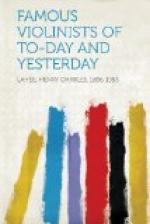From 1830 there has been a constantly increasing number of ladies who have appeared as concert violinists, but few have continued long before the public, or have reached such a point of excellence as to be numbered amongst the great performers.
Mlle. Emilia Arditi, Frauelein Hortensia Zirges, Miss Hildegard Werner, Miss Bertha Brousil, and Madame Rosetta Piercy-Feeny were all born during the decade 1830 to 1840, and were well known, but in 1840 and 1842 two violinists were born who were destined to hold the stage for many years and to exert a great influence in their profession. Wilma Neruda, now known as Lady Halle and Camilla Urso are the two ladies in question, the former exerting her influence chiefly in England and on the Continent, and the latter in America.
Miss Werner has played an important part in advancing the art amongst women, having for many years conducted a school of music at Newcastle-on-Tyne, in England. She was also the first woman ever to address the Literary and Philosophical Society, when in 1880 she delivered an address on the history of the violin. There is little doubt, however, that the success of Teresa Milanollo gave the first great impulse toward the study of the violin by women.
Lady Halle was born at Bruenn, March 21, 1840. Her father was Josef Neruda, a musician of good ability, and he gave her the first instruction on the violin, and then placed her under Leopold Jansa, in Vienna. Wilhelmina Maria Franziska Neruda made her first appearance in public in 1846, at which time she was not quite seven years old. On this occasion her sister Amalie, who was a pianist, accompanied her, and shortly afterwards her father took her, with her sister Amalie and one of her brothers, on an extended tour. The family consisted of two sons—a pianist and a ’cellist—and two daughters—a violinist and a pianist.
In 1849 they reached London, where the young violinist played a concerto by De Beriot, at the seventh Philharmonic concert of that season. By the critics at that time she was said to be wonderful in bravura music, in musical intelligence, and in her remarkable accuracy.
As time went on, and her playing matured, she became known throughout Europe. In 1864 she married Ludwig Norman, conductor of the opera at Stockholm, and for a time she remained in that city and became a teacher at the Royal Music School.
Before long she was again busy with concert playing, and in 1869 she again appeared in England, where she became a great favourite, and has appeared there regularly almost, if not quite, every season since. Hans von Buelow spoke of her as Joachim’s rival, and called her “the violin fairy.”
Joachim has always been a great favourite in England, but Madame Norman-Neruda, or Lady Halle, as she became later, has fully shared his popularity. What Joachim is to the sterner sex, just the same is Lady Halle to the gentler.
Joachim was indeed one of the first to recognise the fact that he had in Mlle. Neruda a rival, for in the days when she was earning her reputation he heard her at some place on the Continent, and remarked to Charles Halle, who afterwards became her husband, “I recommend this artist to your careful consideration. Mark this, when people have given her a fair hearing, they will think more of her and less of me.”




